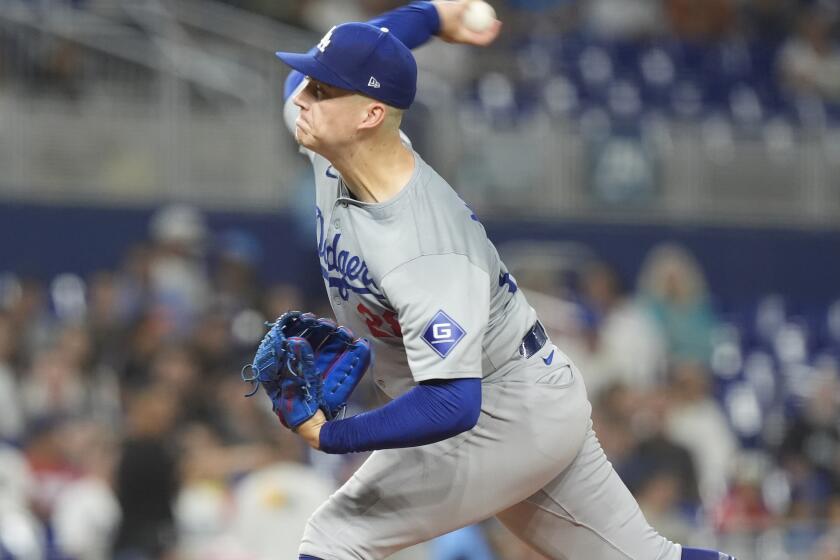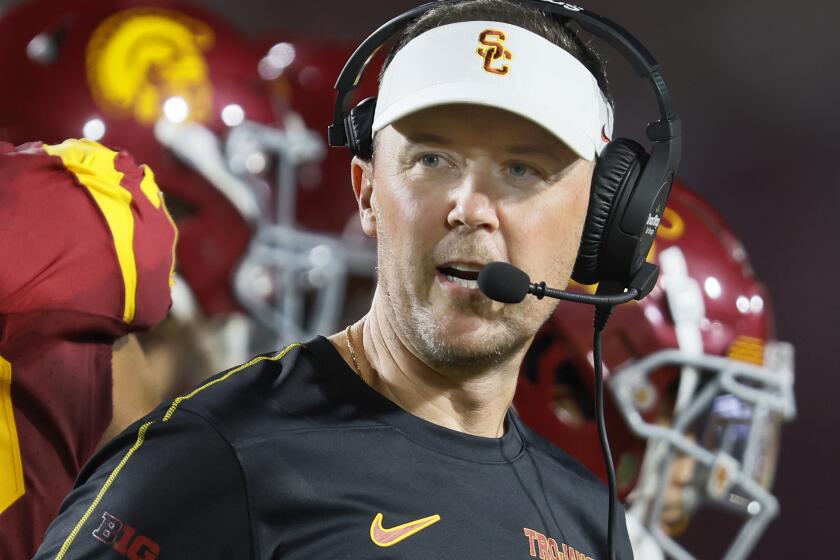Trick or Treat
Ram fans, remembering that the New Orleans Saints knocked them out of the division championship last year, are wondering: Will our undefeated season begin to unravel when the Saints come to town next Sunday?
New Orleans fans, noting that the Rams, en route to a 34-14 rout, executed an onside kickoff with a 31-7 lead over the New York Jets last Sunday, are asking: What will those guys think of next?
Although no authentic answers are imminent, television’s talkers are worried sick that the Rams are beginning to pour it on. One of them, Howie Long, described the third-quarter onside kick as “bush league.” The other second-guessers on the Fox stage, Terry Bradshaw among them, agreed that it was “uncalled for.” They all ignored the reality that improbable comebacks have been a storied part of life in pro football for many years. Just last year, on a memorable Monday night, the Jets were taking a 30-7 drubbing in the fourth quarter when, abruptly, they began a 33-point comeback attack that beat Miami, 40-37. When Ram Coach Mike Martz ordered that onside kick Sunday, he was merely telling the Jets: “You think you’re going to come back on me?”
Ram Trick Plays Win Again
FOR UNCERTAIN REASONS, Martz isn’t getting the national attention he’s earned for the last three years as the NFL’s only venturesome, creative leader. The league’s other coaches all play it safe. Martz attacks. As the founder of what’s being called the greatest show on earth, he is habitually in an attack mode. It’s only a coincidence that in the trick-or-treat month, October, Martz was always playing tricks and getting treats in the Jet game. Three examples:
To break open a 7-7 struggle in the last three minutes of the half, he called a unique option play for a 56-yard touchdown. The play began when Ram wide receiver Az-Zahir Hakim moved into the backfield as a running back, took a handoff, and swept wide for 12 yards, then pitched out to halfback Trung Canidate to get the rest of the easy yardage.
As the Rams stretched away to 31-7 in the third quarter, Martz positioned quarterback Kurt Warner far left as a wide receiver before lining up Canidate as a shotgun passer in an otherwise empty backfield, whence, faking the pass, Canidate sprinted to a 12-yard touchdown on a quarterback-draw play.
It was an instant later that the Rams worked their onside kickoff, ending all hope for the Jets. As a third-quarter call, it was legitimate. Contrary to the Howie Longs, nothing whatever that a winning pro club does in the first three quarters—no pass, no trick play—can be construed as pouring it on.
Martz Proving to Be a Complete Coach
IT’S TIME TO recognize Martz as a candidate (not more than that yet, perhaps) for a theoretical eminence that only three Hall of Famers, Vince Lombardi, Paul Brown and Bill Walsh, have previously reached. I see him approaching greatness—or at least respect—as a complete coach. In their time, Lombardi, Brown and Walsh were, first, original offensive thinkers, as Martz is. But more than that, they excelled in all of the other important aspects of their intricate and difficult game—among them personnel acquisition, defensive understanding, overall organization, and the education and development of individual athletes. And, so far, these have been Martz strengths too.
Though he hasn’t had a chance to stand the test of time, the coach of St. Louis has shown promise as a personnel scout by acquiring unusual star-caliber talent as represented by running back Marshall Faulk, defensive back Aeneas Williams, and Canidate—to name three Rams that any other coach could have had this year. Defensively, Martz has bewildered the NFL with a new team he put together in six months. He showed, first, the vision and force of will to fire eight defensive starters, and then, with the help of a personnel department headed by club president Jay Zygmunt, to install eight new starters along with the right new defensive system and, apparently, the right new defensive leader, Lovie Smith. Most of all, to be sure, Martz is redefining offensive football.
Play Selection is the Secret to the Rams
THE PRO LEAGUE is jammed this season with some pretty good once-beaten or twice-beaten contenders: San Francisco, Oakland, San Diego, Green Bay, Pittsburgh, Chicago, Miami, New Orleans, Philadelphia, New York Giants. There are even some talented three-time losers: Baltimore, Minnesota, Denver, Atlanta, Tennessee, Tampa Bay, the New York Jets. Far above them all, strangely, stands one undefeated team, the 6-0 Rams, who won the Super Bowl two years ago with Martz’s unique offense and who only missed the final round last year after quarterback Warner was twice injured. In the playoffs, Warner was crippled with a concussion.
And, surely, injuries, if any, are all that stand between the Rams and another title-day appearance. Chance of injury is the one invincible NFL negative.
In this era of parity-inducing salary caps and free agency, the creation of this Ram team has been an extraordinary if not-quite well-understood achievement. Looking for explanations, some critics noted last week that Warner and Faulk play most of their games indoors, where the entire club’s rare speed—a Martz priority—seems to overwhelm all comers. By contrast, in the Jet game, they played on outdoor turf, minus Faulk, and destroyed the Jets. As usual, one thing made much of the difference there: play selection. The Rams call more passes on first down than any other team since Walsh’s 49ers. What’s more, their three conspicuous trick plays in the Jet game weren’t the only ones Martz called that afternoon. Nearly every Martz play is a trick play.
Packers Could Play Like the Rams
AMONG MANY OTHER pro clubs this year, the Green Bay Packers own the personnel to do what the Rams do. With quarterback Brett Favre in good health, they are, at the least, better than the Minnesota Vikings, who nonetheless took them apart Sunday, 35-13. The final score to the contrary, this was a game that was won in the first quarter, when the Packers came out overconfident and the Vikings came out confused. With three splendid chances to rock Minnesota in the first quarter—in which Viking fumbles and errant Viking kicking enabled Green Bay, on its first three series, to operate successively at the Minnestoa 49, the Minnesota 16, and the Minnesota 25—the Packers tried to run the ball. They’re proud of their new runner, Ahman Green, who, on his critical carries that day, was stuffed. So in the second quarter, it was still 0-0.
With an aggressive passer like Favre on your team, why would you try to run with Ahman Green (or anyone)? For many years, Favre has ranked with any passer you can name when you let him throw on first down—the very down when, as the Rams keep demonstrating, defensive players have trouble operating aggressively against pass plays because they must ever be alert for runs and passes both. It’s a copout for the Packers to complain that they were jinxed again in Minnesota. They had their chances to put Minnesota away. They beat themselves.
Fouts Harms Clean-Football Campaign
THE TV ANNOUNCERS are part of the problem in the NFL’s continuing effort to interest the country in clean, brilliantly played football. When Howie Long sees a pour-it-on bogeyman in the third quarter of a sensible, sensational Ram approach to a game, he is a contributor. When Monday night announcer Dan Fouts refuses to see late hits, he’s a contributor, as he was the other night. After a referee had flagged a defensive player for an unnecessary assault on a quarterback, Fouts hollered: “That’s a terrible call.” It wasn’t. To the contrary, the illegal hit that time reminded viewers of several that should have been called in NFL games that weekend but weren’t.
The problem with Fouts’ announcement, in addition to the plain fact that it was incorrect, was that it planted a seed that will sprout in referees’ e-mails into the foreseeable future. In the contact game that football is, it’s hard enough, as things are, for an official to throw a flag for too much contact. Like Fouts, the officials are mostly all old pros whose instinct is, along with that of most old-pro announcers, to “let the boys play.” That policy, however, just gets quarterbacks maimed—a frequent happening in recent years. This year it’s different. This year the NFL campaign to keep quarterbacks from illegal crippling hits has been, to date, a success. Few if any pocket passers are down.
Steelers Win with a Halfback Pass
YOU WILL DISCOVER in one of the season’s big Monday games whether the Pittsburgh Steelers are prepared to join the Rams as the league’s next wide-open offensive team. The surprise 4-1 leaders of the AFC Central, the Steelers will be home to the 2-3 but loaded Tennessee Titans in Pittsburgh’s new stadium next Monday night, and although Pittsburgh Coach Bill Cowher has been as conservative over the years as Tennessee’s Jeff Fisher, there was a change in Cowher’s attitude last Sunday.
Finding himself in a losing cause at Tampa Bay on a day that ended happily for him, 17-10, Cowher won by calling a trick play: the halfback option. Because, that time, Steeler running back Jerome Bettis opened up the Buccaneers with a surprise pass, producing a 32-yard touchdown in the 7-3 first half, he could suddenly run in the second half, when he gained all but 25 of his 143 total yards and scored the other touchdown.
The halfback option, which gives a running back an opportunity to either pass or run the ball—whatever’s there—is a weapon that would succeed for most offensive teams much of the time, in spite of which it is either a neglected or never-used play almost everywhere. One strength of the halfback option is that it doesn’t require precision passing. As a rule, the intended receiver is either open or he isn’t. If he is, anybody’s throw will get reasonably close to him, generally close enough to catch. If he’s covered, a running-play lane will thereby be frequently open.
Five-time NFL champion Lombardi made the halfback option one of two staples in his famous offense at both New York and Green Bay. Like Martz in the late 1990s, Lombardi, when a Giant assistant at New York, was an offensive coordinator. His other big play became known as the Green Bay sweep. In a different era, in game after game, Lombardi’s teams moved up and down the field to touchdowns on not much besides these two plays and an occasional third-and-one pass by his quarterback—who at Green Bay was Bart Starr—even though the great coach’s halfback passers, Frank Gifford of the Giants and Paul Hornung of the Packers, were, as both conceded, average passers.
In one regular-season game when Lombardi judged that the Packers needed halfback-option practice, they ran it on seven consecutive plays for 60 yards at Philadelphia, Hornung remembers, and scored the touchdown on his last pass. In today’s football, most NFL teams could doubtless be similarly successful, at least at times, with such a play—yet all but one of them would rather just line up and run the ball. All but two, maybe, if Cowher will open up again Monday night.
More to Read
Go beyond the scoreboard
Get the latest on L.A.'s teams in the daily Sports Report newsletter.
You may occasionally receive promotional content from the Los Angeles Times.










